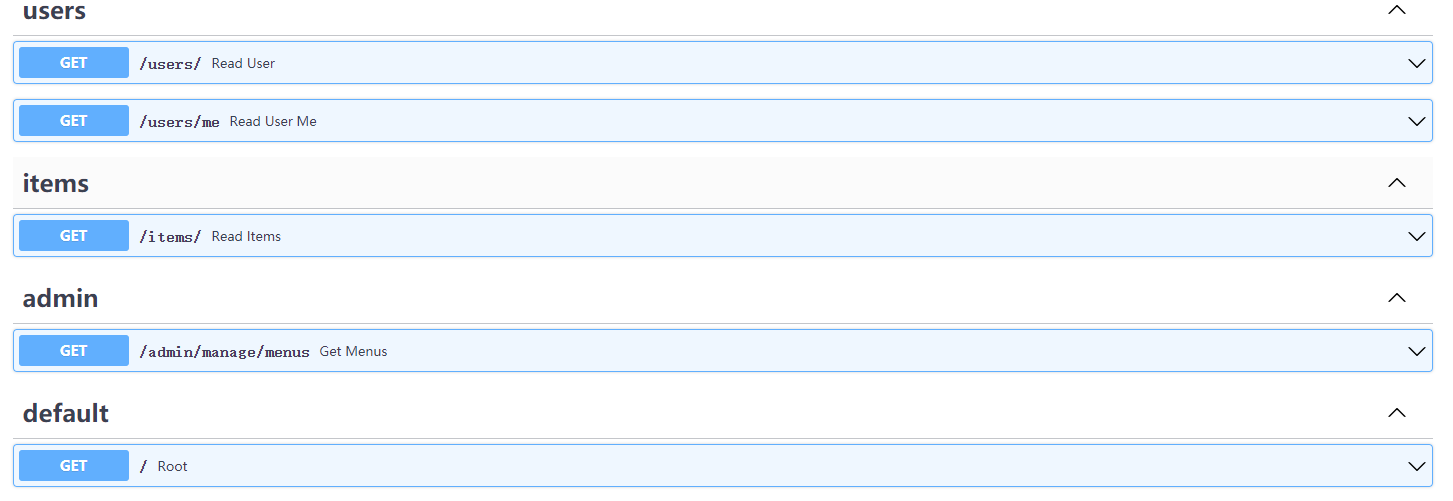一、目录结构分析
FastAPI提供了一个类似Flask的Blueprints功能的工具,它可以在保持灵活性的同时构建应用程序。比如:
. ├── app # 「app」是一个 Python 包 │ ├── __init__.py # 这个文件使「app」成为一个 Python 包 │ ├── main.py # 「main」模块,例如 import app.main │ ├── dependencies.py # 「dependencies」模块,例如 import app.dependencies │ └── routers # 「routers」是一个「Python 子包」 │ │ ├── __init__.py # 使「routers」成为一个「Python 子包」 │ │ ├── items.py # 「items」子模块,例如 import app.routers.items │ │ └── users.py # 「users」子模块,例如 import app.routers.users │ └── internal # 「internal」是一个「Python 子包」 │ ├── __init__.py # 使「internal」成为一个「Python 子包」 │ └── admin.py # 「admin」子模块,例如 import app.internal.admin
假设现在有这样的一个项目,一个Web项目有前台是Vue项目,那么它需要后台提供接口,那么可以将前台的所有接口内容写在routers子包中;另外可能还有一个后台管理的系统,那么它的接口可以使用internal子包来进行管理。
子包中的每一个模块需要解耦开,此时可以使用APIRouter进行管理,可以理解为小型的FastAPI应用,然后将各个部分组合到FastAPI主体上即可。
二、APIRouter
在routers子包中,针对前台不同功能,后台分别有不同的接口模块与之对应,比如items.py与users.py:
- items.py
from fastapi import APIRouter, Depends from dependencies import get_query_token router = APIRouter( prefix="/items", # 前缀只在这个模块中使用 tags=["items"], dependencies=[Depends(get_query_token)] ) @router.get("/") async def read_items(): result = [ {"name": "apple"}, {"name": "pear"} ] return result
- users.py
from fastapi import APIRouter router = APIRouter() @router.get("/users/", tags=["users"]) async def read_user(): return [{"username": "zhangsan"}, {"username": "lisi"}] @router.get("/users/me", tags=["users"]) async def read_user_me(): return {"username": "zhangsan"}
后台功能接口admin.py:
from fastapi import APIRouter router = APIRouter( prefix="/manage" ) @router.get("/menus") async def get_menus(): return [{"title": "用户管理"}]
三、FastAPI主体整合
上述的各个模块需要整合到FastAPI主体上,main.py:
from fastapi import FastAPI, Depends from internal import admin from routers import items, users import sys import os sys.path.append(os.path.join(os.path.dirname(__file__))) #防止相对路径导入出错 app = FastAPI() # 将其余单独模块进行整合 app.include_router(users.router) app.include_router(items.router) app.include_router( admin.router, prefix="/admin", tags=["admin"] ) @app.get("/") async def root(): return {"message": "Application..."}
当然还有一些依赖项要使用,对于全局或者局部依赖项可以写入到dependencies.py文件中:
from fastapi import HTTPException async def get_query_token(x_token: str): if x_token != "secret-token": raise HTTPException(status_code=400, detail="no secret-token...")
当完成这些,可以进行项目启动:
uvicorn main:app --reload
查看交互文档:
